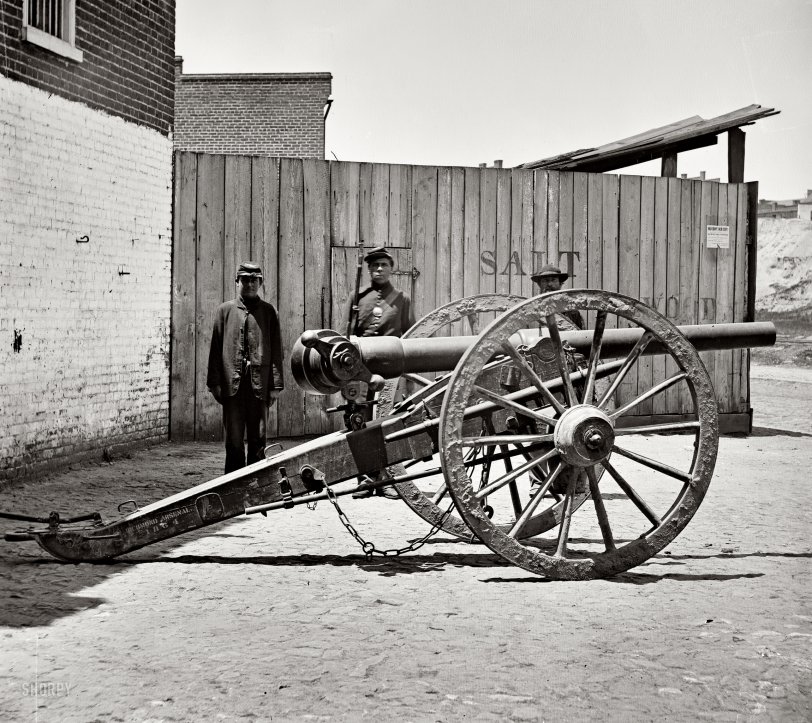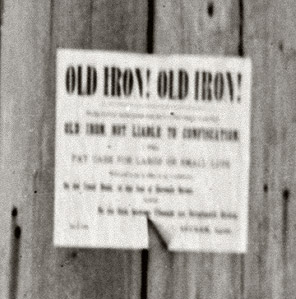


Framed or unframed, desk size to sofa size, printed by us in Arizona and Alabama since 2007. Explore now.
Shorpy is funded by you. Patreon contributors get an ad-free experience.
Learn more.

- Freeze Frame
- Texas Flyer wanted
- Just a Year Too Soon
- WWII -- Replacing men with women at the railroad crossing.
- Yes, Icing
- You kids drive me nuts!
- NOT An Easy Job
- I wonder
- Just add window boxes
- Icing Platform?
- Indiana Harbor Belt abides
- Freezing haze
- Corrections (for those who care)
- C&NW at Nelson
- Fallen Flags
- A dangerous job made worse
- Water Stop
- Passenger trains have right of way over freights?
- Coal
- Never ceases to amaze me.
- Still chuggin' (in model form)
- Great shot
- Westerly Breeze
- For the men, a trapeze
- Tickled
- Sense of loneliness ...
- 2 cents
- Charm City
- What an Outrage
- Brighton Park
Print Emporium
Ready to Roll: 1865

April 1865. Richmond, Virginia. "Federal soldier guarding Whitworth gun on wharf awaiting shipment." Wet plate glass negative. View full size.
Query
Anyone know where they keep the salt around here? Looking for some wood, too.
Fine photo of a rare gun
First time I have seen that photo in high res. Wonder if the Rebs ever had a chance to use it.
Specs
2.75-inch Whitworth Rifle. Imported from England by both North and South; only the Confederacy actively used these unique guns in the field. Designed by Sir Joseph Whitworth before the American Civil War, it fired an elongated 12-pound iron shell which fit snuggly into the fine rifling of the tube. It was also unusul in that it was a breechloader. A locking ring around the breech allowed the end of the gun to be opened so that the shell and powder charge could be loaded through the breech. The gun's unusual shape and distinctive shells were a curiosity when compared to other ordnance, though they were extremely accurate and could fire a solid shot beyond 2,800 yards. Two of the guns were in use by Hurt's Alabama Battery at Gettysburg and the shrill whine of the Whitworth shells was distinguishable above the roar of the cannonade before Pickett's Charge. Though the Whitworth cannon was very accurate, it had a myriad of problems with the breech mechanism. According to Colonel E.P. Alexander, the Whitworth was not as desirable a weapon as the 3-inch Ordnance Rifle.
War Prize
Whitworth guns were bleeding-edge technology at the time and the Confederates were the only service to use them in combat.
Whitworth guns
About a dozen Whitworth cannons were brought through the Blockade to the South from England. They were breech loaders that utilized a hexagonal cross section bore and projectile and had a range of about five miles. Whitworth also made and exported through the blockade quite a number of sniper rifles that used the same hexagonal bore, but were muzzle loaders. Excellent for bringing down Yankee officers who thought themselves safe because of the distance from Rebel troops.
Unfortunately for the Whitworth cannon, the art of artillery spotting had not advanced to the point where the long range and accuracy of the gun could be properly utilized.
Old Iron! Old Iron!
What about it?
[Hmm. "Old iron not liable to confiscation." So I guess my laundry room is safe from the Yankees. - Dave]

























On Shorpy:
Today’s Top 5